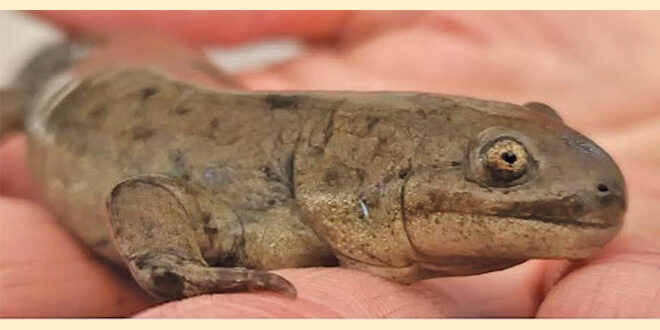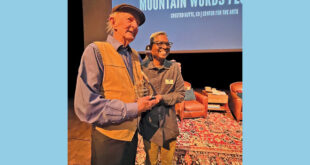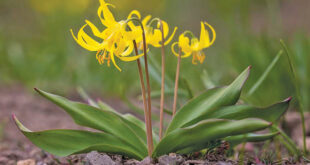When a Salamander Speaks
By Howard Whiteman, rocky mountain biological lab
I remember the moment like it was yesterday. My students and I were sampling a pond in the Upper Cut, which is part of a nature preserve that, at the time, I had been studying for almost three decades. I know that sounds like a long time; it is.
We were looking for adult salamanders that had crawled up the mountain looking for food. Those salamanders were born in the Lower Cut, which is where all salamanders at the site have always been born—or so we thought. Some of the ponds at the Upper Cut have abundant prey, and the salamanders migrate to the ponds to get them.
The two shelves of ponds are only 50 meters different in elevation, but that difference seems vast when you make the hike yourself. It has always been strenuous, yet the salamanders make the trek regularly.
As we searched for the adults, one of my students yelled out that they saw a larva, which for a salamander is like a tadpole, an aquatic larval stage that amphibians use as they progress from an embryo into an adult.
“No, you didn’t,” I immediately, abruptly, rudely and naïvely retorted. There was no way for this to happen, for my reality to have changed. For this to be true, salamanders would have to be breeding in the Upper Cut, something no one had previously observed—even researchers that had worked on the ponds decades before me.
But there they were, over a dozen of them, born late the previous summer and now a full year old. In a pond such as this one, abundant invertebrate food and warm temperatures meant they could grow quickly, and before the end of that summer they were large enough for me to mark individually. Since then, some of them have come back to breed themselves.
That was my climate moment. It was at that moment, when my students first observed the larvae, that I realized that this pristine nature preserve on top of the Rocky Mountains was not immune to the changes that were already affecting other parts of our planet. Salamanders can’t talk, but they were speaking to us nonetheless, and telling us that their world, and ours, is changing.
Looking back, I should have known it was coming. Indeed, the data was right in front of me, as I would travel by a weather station every day on my way to the ponds. That weather station, which is a conservative estimate of changes at the ponds because it is at a lower elevation, has shown that temperatures have increased over 5oF —1.7oF per decade—in the time I have been studying these ponds, which is much faster than most of the planet, but on par with what we are seeing at other high elevation and high latitude sites. The planet is warming, but not equally everywhere, and mountains are among the areas of greatest change.
Since my climate moment I have focused much of my research on learning what else the salamanders are telling us about climate change. My collaborators and I have learned that climate is important not only to salamander growth and development but also to how long they live and how early they reproduce.
We have found that these salamanders are changing from a species that is adapted to high elevations to one more suited to lower elevations. As high elevations are becoming more like lower ones, the salamanders are growing faster and bigger, maturing earlier, and not living as long, which is similar to their lower-elevation cousins. In a nutshell, salamanders are adapting to a warming planet.
Salamanders are adapting because they have to. Unlike humans, they cannot alter the rate at which we burn fossil fuels. They have no choice but to change with the planet.
We are different. The choice we have is between adaptation—like the salamanders—and mitigation. For humans, adaptation means finding ways to live in a world where high temperatures, violent storms, drought, wildfires and rising sea levels affect our daily lives.
Mitigation means finding ways to reduce the effects of climate change, from limiting our use of fossil fuels to finding new ways to capture and store carbon. We have many of the technologies needed to make the transition to renewable energy sources and to begin cleaning our atmosphere, but we currently lack the political will to make it happen.
These choices trade off with each other. The more mitigation, the less adaptation we have to do. The less mitigation, the more our lives will be disrupted, and the more change and hardship we (and our ancestors) will bear in the future.
If we can hear one thing that the salamanders are telling us, it’s that climate change is real. They know it is, and they have shown it by breeding at higher elevations and starting to adapt to the warmer temperatures and longer growing seasons.
The question remains whether we can hear their message, and how we respond to it. I’ve heard the salamanders loud and clear. What about you?
If you would like to hear more about what salamanders are telling us about climate change, I’ll be giving a public seminar at the Carnegie Science Center on Monday, February 24 at 5 p.m. MT, and you can participate online. The seminar is free, and you can find out more information and register using the QR code next to the photo.
 The Crested Butte News Serving the Gunnison Valley since 1999
The Crested Butte News Serving the Gunnison Valley since 1999





